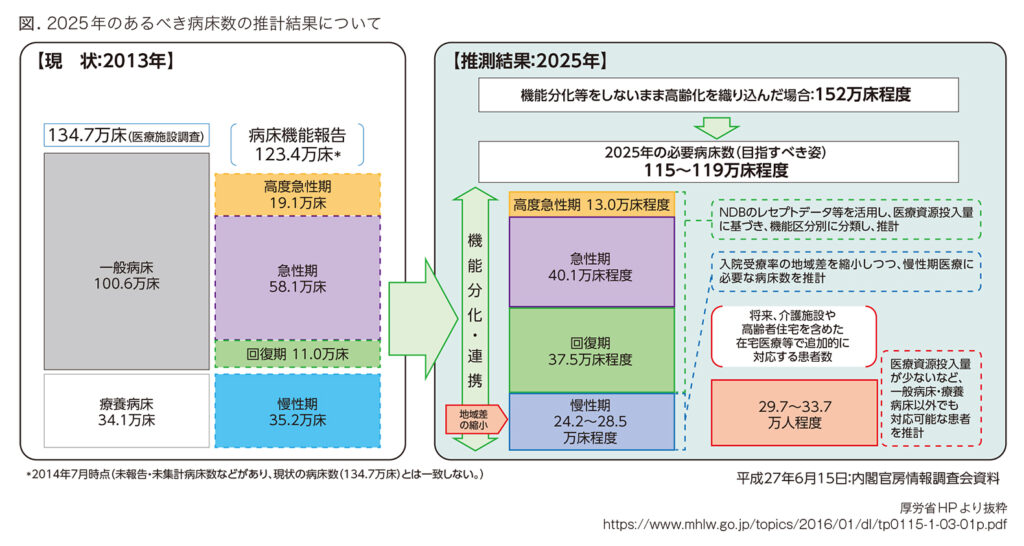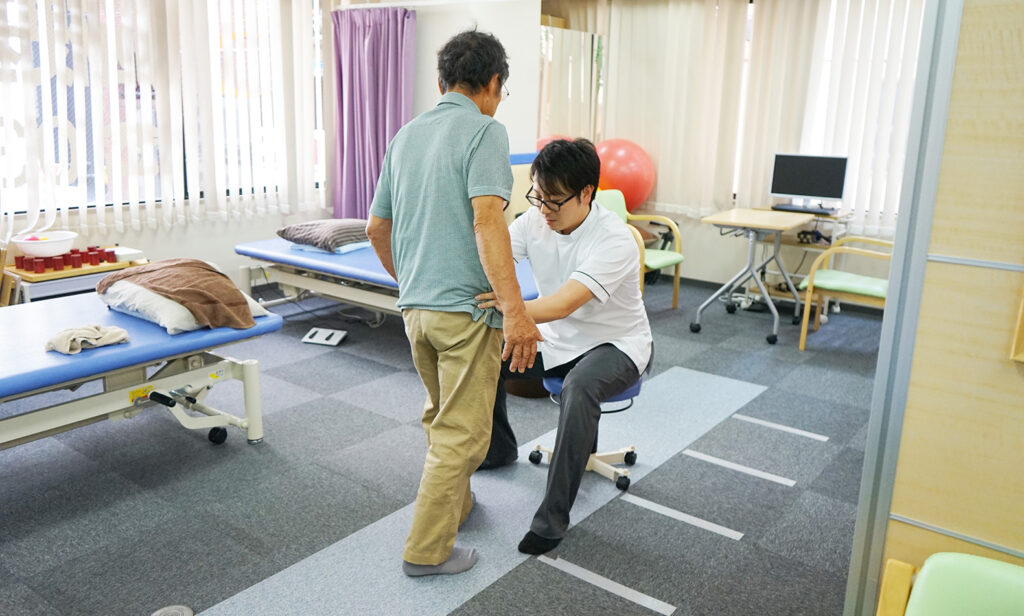ASOURCE®TIMES
2025年問題を見据えて、病院の回復期病棟の充実が喫緊の課題となっており、国としても急性期病棟から回復期病棟への転換を誘導しつつある。その一方で、医療費抑制の一環として、医療保険が適用されるリハビリ期間が制限されたため、「リハビリ難民」が増えたともいわれる。そこで台頭してきたのが保険外で全額自己負担のリハビリを提供する自費リハビリである。費用はかかるが、多くのニーズがあるとされる。そこで、病院の機能分化の方向性と自費リハビリの役割についてレポートする。

2025年には、団塊の世代が75歳以上となるため、病院・病床の機能分化・連携の推進が望まれている。急性期の病床を減らし、回復期病床や在宅医療を増やそうと、国が17年3月までに都道府県に策定させたのが「地域医療構想」である。病院のベッドを「高度急性期」、「急性期」、「回復期」、「慢性期」の4機能に分け、全国341の「構想区域」ごとに25年の必要病床数を推計している。人口減などに伴い、急性期と慢性期の病床は過剰になると予想され、回復期への機能転換や在宅医療への移行が進められる、とみられている。今後25年までの構想実現に向けて各地域で病床の機能転換や削減の議論が展開される運びだ。
各都道府県の策定した地域医療構想における機能ごとのベッド数を積み上げると、2025年に必要と思われる病床数は、高度急性期13.0万床、急性期40.1万床、回復期37.5万床、慢性期24.2万〜28.5万床となる(図)。
翻って、2014年の病床機能報告では、高度急性期19.1万床、急性期58.1万床、回復期11.0万床、慢性期35.2万床である。病床機能報告とは、一般病床と療養病床を持つ全ての病院・有床診療所が、自院の各病棟が「高度急性期」、「急性期」、「回復期」、「慢性期」のどの機能を果たしているのか、また、将来果たすことになると考えているかを都道府県に報告するものである。
地域医療構想の将来設計と病床機能報告とは単純比較することはできないが、国としては、急性期から回復期への機能転換が必要、との考えとされる。

こうした中で、急性期病棟から回復期病棟へ転換する施設もみられるようになってきた。2018年度診療報酬改定では、回復期リハビリテーション病棟入院料は6区分に再編され、実績指数の要件を満たしている場合により高い点数を算定できるようになった。実績指数を高めるには、入院期間を短くするか、機能性自立度評価表利得を大きくする必要がある。また、回復期リハビリ病棟入院料1を策定する病院では、リハビリ専門職が退院後180日以内に限り退院患者の外来リハビリに当たることが可能となった(算定日数上限を超えて算定を認めていた経過措置は2019年3月で廃止)。
回復期リハビリ病棟の退院後も障害が残るケースは少なくない。外来リハビリのほか、疾患別リハビリ料の算定日数上限(180日)を超えた要支援・要介護者に関しては、介護保険による通所リハビリなどもあるが、メインとなるのが集団でのリハビリなため効果が限定的であり、十分な個別リハビリを受けることは難しい。「リハビリ難民」が続出するのではないかとの見方も出されている。
このようなニーズに対応しようとしているのが自費リハビリである。保険外で全額自費のリハビリを提供する。
早くから保険外リハビリに取り組んでいるのが、株式会社ワイズである。1都5県(東京・神奈川・埼玉・千葉・新潟・熊本)で「脳梗塞リハビリセンター」を12箇所で展開している。公的医療保険や介護保険で受けられるリハビリに満足できない脳梗塞などの患者向けに独自のリハビリを提供している。
従来のリハビリにおける目標は、制度設計上、時間が限られ日常生活動作の回復が主にならざるを得ない。一方で、近年、働き盛りの世代の患者を中心に、職場復帰を見据えたリハビリの需要が多くなっている。介護保険では、高齢者向けが多く、集団リハビリが中心で、機能の改善よりも維持が目的となっており、不満を感じる人が少なくない。
支えながら、一歩一歩前に踏み出す歩行訓練
 株式会社ワイズ提供
株式会社ワイズ提供
同センターでは、個人の希望や症状に合わせ綿密なリハビリ計画を立て、理学療法士(PT)や作業療法士(OT)、言語聴覚士(ST)らがマンツーマンで対応する。施術の流れとしては、鍼灸(約45分)、PT/OT/ST(約60分)、トレーニング(約15分)。自宅で行える自主トレーニングの提案や、家族へのアドバイスもする。回復期・急性期リハビリ病院で豊富な経験を積んだセラピストが担当する。基本プランでは、60日間、週2回、1回当たり2時間受ける。費用は27万5000円(税別)。
利用者は3,000名を超える。その内訳としては、脳卒中発症後1年以内が、5割を超え、年代別では、40〜60代が65%を占める。職業としては、会社員のほか、理容師、寿司職人、音楽家や医師など専門職も多く、パソコン操作や職人特有の機能回復の達成が目標となる。脳卒中の後遺症では、足よりも手の麻痺のリハビリにより時間がかかるといわれる。
同施設のリハビリの効果については、2018年の日本脳卒中学会で報告された。それによると、脳血管疾患によって後遺症を負い、発症からの期間は1年未満から10年以上の33人の利用者に対して60日間の集中的なリハビリを実施したところ、客観的評価で身体的機能が改善された人が81%、主観的改善を実感された人が77%に上ったという。発症1年以上の人がおよそ3分の2を占めており、発症から6ヵ月以上経過しても改善する可能性が示された。
自身がヘルニアで手術を受け、リハビリによる回復の喜びを経験した同社会長の早見泰弘氏は「退院後も集中してリハビリに取り組むことで良い結果を出せる利用者が多くいる。働き盛りの世代の職場復帰を支援したい」と話している。
最近では、回復期病院のドクターが施設を見学に来たり、患者を紹介したりするケースも増え、医療者からの理解が進みつつある。大学病院と共同で線維筋痛症に対するリハビリにも取り組んでいる。
今年2月には豊田通商の子会社「豊通オールライフ」も都内に自費でリハビリを行う施設を開設させた。利用者の症状に合わせて、理学療法士などが個別にリハビリ計画を作成する「オーダーメイド型」のサービスを打ち出している。
脳卒中は2025年には300万人に増え、要リハビリ患者数は150万人に上ると推定され、リハビリの需要性はますます高まるものとみられている。